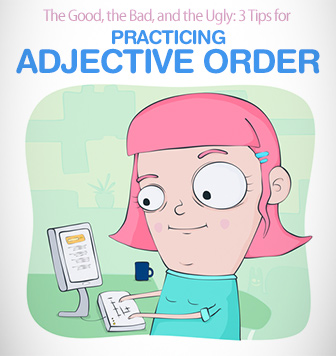The Biggest and Baddest of Them All: 5 Fun Activities for Practicing English Adjectives


Take the guesswork out of adjective order by practicing these three tips to establish what comes first, the good, the bad, or the ugly.

Once learners have discovered the abundant descriptive language that exists in adjective use, they will be eager to begin stringing them together. When first introducing adjective order, explain that there is a specific order when you have two or more adjectives together in a sentence. This explanation tends to take awhile because you want to supply a lot of detail, extricate input from your audience, and do lots and lots of examples. In order to help students remember the order, you can give them the acronym of: O SASh.COM. Here's where you want to detail your explanation with examples that provide as much clarity as possible. Below are some guidelines to assist your initial explanation.
O SASh.COM stands for Opinion, Size, Age, Shape, Color, Origin, and Material.
Opinion always comes first, and you can tell your students it's because opinion is always the most important. Sometimes it is difficult to tell the difference between one of the other components and opinion. You could compare fact and opinion so that students have a clear idea that when expressing opinions with adjectives, the information is subjective. Showcasing adjectives like beautiful, handsome, wonderful, or delicious make it clear that what one person finds beautiful another person might call ugly; it is simply a matter of taste. Ask students to give you lots of examples of opinionated adjectives.
Size comes next and this is pretty self-explanatory, but it shouldn't be confused with shape. Size is how large or small something is.
Age is also pretty clear, and you can show them how to add in specific ages, like a fifteen year-old boy.
Shape is how something can be described, and often students haven't learned too many of these adjectives when adjective order comes up. Introduce things like, circular, boxy, square, rectangular, oval, etc.
Color is obvious and easy. This can be a good time to add in some more complex colors that students might not know yet. Pull out a box of crayons for endless examples.
Origin tends to be confusing for students, even though it can pretty easily be equated with nationality or where things come from.
Material is understandable for students, but they just don't have a lot of vocabulary to express it. This is a good time to introduce specific types of metals and fabrics. You can define things like cotton, rayon, silk, wool, silver, gold, etc.
There is one last category not included in the acronym because it is fairly obscure and a bit more advanced. That is the purpose of something. These adjectives often end in -ing. Examples are: a rocking chair or a sleeping bag.
All of this explanation combined with brainstorming examples for each category takes some time. To start doing some ordering, you could write out two to three adjectives and ask students to put them in order, and explain why. After such a lengthy explanation doing some simple ordering in rounds or at the board is a good wrap-up comprehension check for a substantial lesson. You could also do a grid n the board with each category at the top and words underneath, like this:
| Opinion | Size | Age | Color | Origin | Material | |
| A | nice | young | American | girl | ||
| A | big | blue | car | |||
| A | happy | tiny | furry | puppy |
Performing line-ups for adjective order is a significant and memorable practice exercise with simple set-up. Have a large stack of cards with adjectives of all categories. Give each student a card and tell them to order themselves at the front of the room according to OSASh.COM. Applying a time-limit generally helps chaos ensue, and students will quickly jump into teamwork mode. In your stack of cards, it is advisable to have a few wild cards that will really get students thinking. Also include newly-acquired vocabulary to make the activity that much more meaningful. Do several rounds of the line-ups with many new adjectives so that each round is as challenging as the last, if not more so. Allow students to get loud and encourage them to problem solve by interacting with language.
Once students have substantial understanding of adjective order, you can begin introducing punctuation of multiple adjectives. In order to display comma usage, tell students you are going to create the longest sentence possible, as a group. Start out with a simple sentence of your choosing or have the students contribute. For example, Juan is a boy. Tell the students to begin adding adjectives to make the sentence longer and add punctuation as they go. For example: Juan is a handsome, smart, wonderful, happy, tall, young, African boy. At this point the sentence needs to take on more complexity. Add in a clause like who or that likes/hates/wants and have students do more of the same exercise adding in more and more adjectives in correct order, and with correct punctuation. By the time you are done, you should have a sentence on the board that is forty to fifty words long. You could also do this activity in groups or pairs where the students attempt to tell a short story in adjectives and in the way they punctuate. It can be done verbally or in writing.
Use these three tips for practicing adjective order and students will stun you with how smart, youthful and smooth they are.